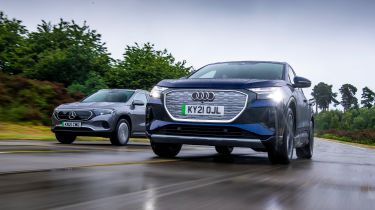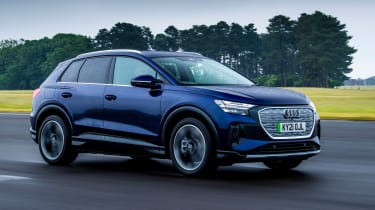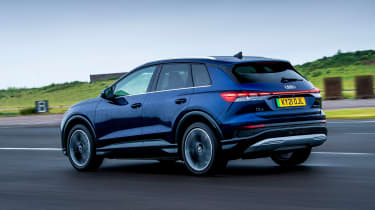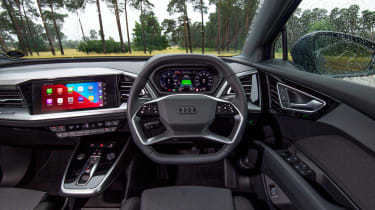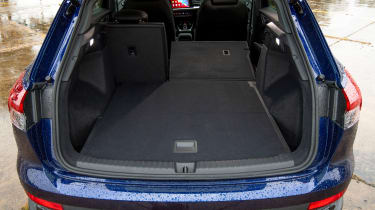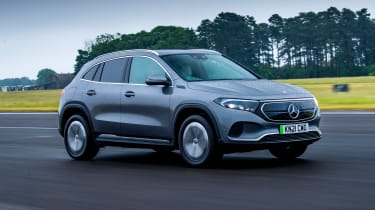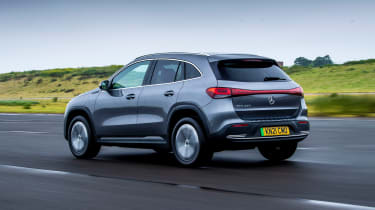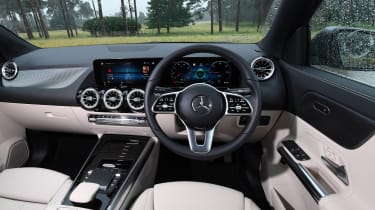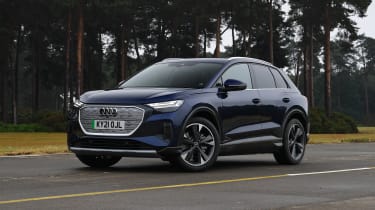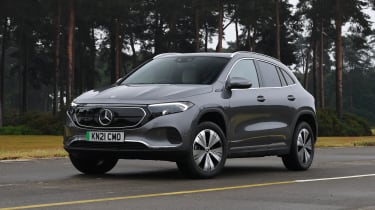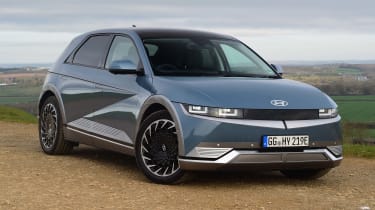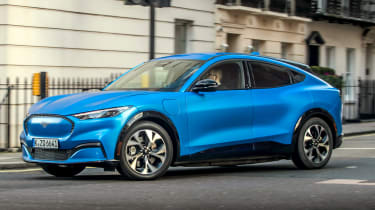Audi Q4 e-tron vs Mercedes EQA
The Audi Q4 e-tron and Mercedes EQA tough it out for luxury small electric SUV honours
The electric car segment continues to grow at a relentless pace. Despite the fact that 2020 new- car sales dropped 29.4 per cent below 2019 levels due to the Covid-19 pandemic, EV sales increased to 108,205, a huge 186 per cent up on the year before. The increase continues, too; battery-electric vehicles take up 7.5 per cent of the new car market in 2021.
And with cars like the Audi Q4 e-tron hitting showrooms, it’s only a matter of time before EVs become the dominant force in the market. Here is a family-sized SUV that erases most issues brought up by electric sceptics: a 300-mile-plus range between charges, rapid charging and, in the case of the entry-level model, a price that slots neatly between Audi’s combustion-powered SUVs, the Q3 and the Q5.
But Audi is far from having things all to itself. Mercedes has its own challenger: the EQA. It shares much with one of our favourite posh SUVs, the GLA, so should prove stern competition for the Audi. Which comes out on top? We put them to the test.
Audi Q4 e-tron
| Audi Q4 e-tron 40 Sport | |
| Price: | £44,275 |
| Powertrain: | Electric motor/lithium-ion battery, 201bhp |
| 0-62mph: | 8.5 seconds |
| Test economy: | 3.4 miles/kWh |
| CO2: | 0g/km |
| Annual road tax: | £0 |
The Q4 e-tron sits below the existing e-tron as the new starting point in Audi’s all-electric SUV line-up. It’s tested here in 40 Sport trim, priced at £44,275, but our test car has some extras that aren’t available in this spec in the UK, including the ambient lighting pack, rear privacy glass and 20-inch alloys.
Used - available now

2023 Land Rover
Discovery
13,183 milesAutomaticDiesel3.0L
Cash £57,500
2021 Audi
A6 Avant
14,676 milesAutomaticPetrol2.0L
Cash £30,000
2021 BMW
1 Series
13,199 milesManualPetrol1.5L
Cash £17,600Design & engineering
The Volkswagen Group’s aggressive EV strategy has been spearheaded by its MEB platform, which is set to become one of the most ubiquitous of its type over the coming years. While we’ve seen its use in the VW ID.3 and ID.4, plus the Skoda Enyaq, the Q4 e-tron is Audi’s first application of the tech, taking the premium SUV approach. At 4,588mm long and 1,632mm tall, the Q4 slots neatly between the brand’s combustion-powered Q3 and Q5 in terms of overall dimensions.
One of the MEB architecture’s benefits is that it’s offered with a wide range of motor configurations and battery sizes. The 40 powertrain tested here pairs a 77kWh battery with a 201bhp rear-mounted electric motor. Officially, the Q4 will cover 316 miles on a charge. The range kicks off with the 35, which gets less power (148bhp), a smaller battery (52kWh), and a reduced range of 208 miles.
A range-topping model, badged 50, will join the line-up later on. This gets a second motor up front, which bumps the power output up to 295bhp, enough for a 0-62mph time of 6.2 seconds. That’s 2.3 seconds faster than the 40 trim tested here. The 40 and 50 share the same size of battery pack, but the latter car covers less distance between charges, at 298 miles.
Driving
Our Q4 e-tron came equipped with adaptive dampers, a £950 option. We found it best to leave them in Comfort mode, where the more relaxed setting prevents many bumps that caused the car to jiggle about in Sport mode from making it through to the cabin.
Given that this is a fairly tall electric SUV that weighs just over two tonnes, the dampers’ influence over handling has less of an effect. Regardless of its setting, the Q4 feels very stable, whether it’s cruising on a motorway or when the chassis is surprised by a mid-corner drain cover on a twisty road. Although its steering is heavier than the Mercedes’, the Audi also feels a little more keen to turn into a corner than the EQA, and more balanced through it; the rear-wheel- drive layout plays a part here. It’s a stretch to call either car exciting to drive, but that’s hardly the point.
Yet there is some joy to be had when accelerating. The 0-62mph time is 8.5 seconds (0.4 seconds faster than the EQA), but as with most electric vehicles, the on-paper figures don’t really tell the whole story. At low speeds the Q4 jumps away from the line keenly – particularly in Dynamic mode, where the throttle response is at its sharpest – yet that lively performance continues at motorway speeds, too.
Practicality
One of the benefits of an EV platform is that the electric powertrain is much easier to package. An electric motor is much smaller than a combustion engine, and the battery can be stored beneath the floor. The Volkswagen Group has really exploited this advantage; few cars manage to make such an efficient use of space as those of the MEB family.
The Q4 e-tron is no different. At 4,588mm, it’s a modest 104mm longer than Audi’s own Q3 and 125mm more than the Mercedes EQA, but inside it is vast compared with either. Rear legroom is a particular highlight, while the floor is almost completely flat, so it’s even more than adequate with three people sat across the back row. Headroom is also great, and there are lots of clever storage options up front to help hide away various trinkets, although the door bins are a little small.
But cabin space hasn’t come at the expense of boot capacity: the 520-litre load bay – a figure that grows to 1,490 litres when the rear seat backs drop down completely flat – is almost on a par with the bigger Q5 SUV’s. The optional Function Package adds a variety of storage nets, plus a luggage compartment cover that can be stowed under the boot floor.
Ownership
Buyers of premium cars have very high expectations for the ownership experience, and based on the results of our latest Driver Power survey, neither Audi nor Mercedes live up to the promise.
Audi’s range as a whole finished a disappointing 21st place overall out of 30 brands in our 2020 survey, while its dealers were ranked a middling 13th out of 25. Mercedes fared worse still, with its dealers named 21st best, while as a manufacturer it ranked near the bottom, in 28th spot.
Running costs
While our readers think that Audi and Mercedes’s dealers might not be the best people to interact with, the saving grace is that with an electric vehicle, you won’t need to visit them so often.
An electric powertrain needs much less maintenance than a combustion-engined car, and this is reflected in the Q4 e-tron’s two- year/19,000-mile service intervals.
Both of these cars spent a significant proportion of their time on test being driven at motorway speeds – the least flattering conditions for an electric vehicle – but in more favourable warm weather.
The two SUVs achieved a little over three miles per kilowatt hour of energy used on test, which meant that the Q4 promised a real-world range of 262 miles to the EQA’s 206 miles. With predominantly urban driving, the Audi was hovering around the 4.2m/kWh mark – which translates to a real-world range of 323 miles. That slightly exceeds the Audi’s official WLTP rating of 316 miles on a single charge.
Testers’ notes
“Tire of your car’s look easily? The Q4 e-tron has you covered; spec the optional Matrix LED headlights and you can switch between four different LED lighting graphics via a menu in the touchscreen.”
Mercedes EQA
| Mercedes EQA 250 Sport | |
| Price: | £44,495 |
| Powertrain: | Electric motor/lithium-ion battery, 187bhp |
| 0-62mph: | 8.9 seconds |
| Test economy: | 3.1 miles/kWh |
| CO2: | 0g/km |
| Annual road tax: | £0 |
As with the Q4 e-tron, the EQA is currently the smallest and least expensive vehicle in the German manufacturer’s electric car line-up. Here we’re testing the £44,495 EQA 250 Sport, which thanks to optional metallic paint (£595), a Driving Assistance Package (£1,695), and a trailer coupling system (£750), comes to a total of £47,535.
Design & engineering
While the new Q4 e-tron uses EV-specific underpinnings, Mercedes has taken a more conservative direction with its first generation of fully electrified vehicles. That means the EQA rides on an adapted version of the Stuttgart brand’s Modular Front Architecture platform, making the EQA closely related to the combustion-powered GLA compact SUV.
That is clear to see in the car’s proportions; at 4,463mm long, only a few millimetres separates the EQA from GLA, which is a result of differing bumper designs. The pair share a wheelbase of 2,729mm.
However, the EQA gets distinct styling front and rear, including full-width LED light bars at either end. There’s also a smoother look overall to the bumpers and detailing, which is all in the name of improving aerodynamic efficiency. A drag coefficient of 0.28Cd is very slippery for a tall-ish SUV, and is identical to the Audi Q4’s figure.
Inside, the GLA origins are clear to see. The EQA’s dashboard is nearly identical to the combustion-engined variant, as are the basic controls; the column-mounted gear selector remains, and the steering wheel is of an identical design. In any other company it’d look contemporary, but compared with the Q4’s concept-like design, the EQA’s cabin is almost traditional, particularly with the attractive cream leather of the car in our pictures.
While the Audi features a rear-mounted motor, the EQA 250’s is located at the front, and sends 187bhp and 375Nm of torque to the wheels. Two motor options higher up the range send drive to all four wheels; the EQA 300 4Matic offers 225bhp and 390Nm, while the most potent EQA 350 4Matic raises those figures to 288bhp and 520Nm, enough for a 0-62mph time of just six seconds. All three variants use the same 66.5kWh battery.
Driving
Around town, the EQA feels very easy to drive. The high seating position certainly helps here, yet so does the steering, which is both light and at full lock turns more tightly than an 11.4-metre turning circle suggests.
Neither of these cars is particularly fun to drive, but the Audi feels marginally the more competent of the two. The Mercedes is prone to understeer when pushing into a corner, but on the other hand the EQA rides fairly smoothly, and for the most part, refinement is very good.
While electric cars tend to be significantly smoother and quieter than combustion-engined alternatives, the peace in the Mercedes is let down slightly by a high-pitched whine from the motor under hard acceleration; it’s a minor complaint, but it’s one area where the Q4 gains an advantage. The throttle response can feel inconsistent, too; it means that when you try to crawl along in traffic it can be harder than it should be to maintain a constant speed.
Practicality
Although the Audi proves to be the more practical car, that’s not to say that the EQA is cramped, rather that it’s going up against an exceptionally well packaged opponent.
Back-seat occupants in the Mercedes still get lots of headroom and reasonable kneeroom, while the tall doors make it easy to get in and out. The only real criticism comes with the floor; it’s quite high in relation to the seat base, so those in the back will find their legs raised away from the squab, and are left with little foot space underneath the front seats.
That high floor is a result of the battery pack stored under the cabin, and it affects the boot capacity, too. At 340 litres, it’s down on a typical family hatchback, and 100 litres less than the GLA on which it’s based. Unlike the Audi, there’s no under-bonnet load space and no dedicated cable storage in the back. The rear seats split 40:20:40 and fold almost flat. Like this, total volume is 1,320 litres.
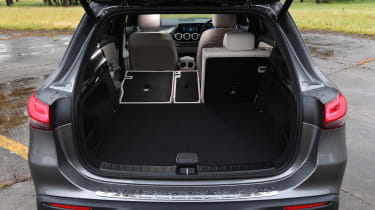
The ability to tow is still a novelty to many EVs, yet it’s something both of these cars can do. The Q4 e-tron just edges the EQA 250’s limit: 1,000kg versus 750kg. But more powerful 300 and 350 variants of the EQA can pull a braked trailer of up to 1,800kg.
Ownership
Neither of these cars has been tested by Euro NCAP yet, although both have similar counterparts that have fared strongly. In the case of the EQA it’s the A-Class, with which it shares a platform, and which achieved the maximum five-star rating back in 2018, but this, of course, is for a combustion-powered car rather than a full EV. For the Q4 e-tron, its MEB cousins the Volkswagen ID.4 and Skoda Enyaq both bagged maximum scores earlier this year.
Running costs
Not only are these two cars going to be far cheaper to run than an equivalent combustion-powered SUV, but they also hold their value exceptionally well. The EQA fares marginally better here, clinging on to more than 58 per cent of its original value after three years or 36,000 miles, to the Q4’s 57 per cent.
Thanks to the zero tailpipe emissions of electric cars, it’s hard to overlook the cost benefits to a company car user, too. Based on the current Benefit-in-Kind calculations, the pair fall into the lowest one per cent category. That means that the Audi and the Mercedes cost only £180 and £178 respectively per year for higher-rate earners. A petrol or diesel SUV of a similar size will cost thousands of pounds over the same period.
Testers’ notes
“Adaptive dampers can really add an extra degree of control and comfort to any car. It’s a shame, then, that only the most expensive EQA trim gets this technology.”
Verdict
First place: Audi Q4 e-tron
With the Q4 e-tron, Audi hasn’t just produced a brilliant EV, but one of the best premium SUVs around. For its size, it’s immensely practical, refinement is excellent and it’s relaxing to drive. The real-world range is great, and it lifts all the best infotainment tech from the existing Audi line-up, too. It manages to edge the Mercedes by small margins in almost every area, so it takes a deserved win.
Second place: Mercedes EQA
Although the Mercedes has to settle for second place in this test, it’s still a very desirable electric SUV. The interior technology is impressive, it’s relaxing to drive, and for most people the EQA will be spacious enough. However, for the same cash the Audi is much more practical, slightly better to drive and can go further on a charge than its German competitor.
- Model: Hyundai Ioniq 5 Ultimate
- Price: £48,145
- Powertrain: 73kWh battery, 301bhp
The eye-catching Ioniq 5 has substance to match its concept- car looks. In terms of power and charging tech it has both rivals here covered and, boot aside, it’s as practical as the Audi. It’s comfortable to drive and has a great interior. It’s a huge amount of EV for the cash.
Ford Mustang Mach-E
- Model: Ford Mustang Mach-E standard range RWD
- Price: £41,330
- Powertrain: 75kWh battery, 265bhp
The Mustang Mach-e is the electric SUV of choice for the keen driver, with great handling and steering. Some interior areas lack our test duo’s premium feel, but the huge infotainment screen is bang up to date. The standard-range car undercuts this pair on price.
Figures
| Audi Q4 e-tron 40 Sport | Mercedes EQA 250 Sport | |
| On the road price/total as tested | £44,275/£52,685 | £44,495/£47,535 |
| Residual value (after 3yrs/36,000) | £25,241/57.0% | £25,998/58.4% |
| Depreciation | £19,034 | £18,497 |
| Annual tax liability std/higher rate | £90/£180 | £89/£178 |
| Annual electricity cost (12k/20k miles) | £459/£765 | £503/£839 |
| Insurance group/quote/road tax cost | 29/£1,260/£0 | 42/N/A/£0 |
| Service intervals | 24 months/19k miles | 12 months/15k miles |
| Length/wheelbase | 4,588/2,764mm | 4,463/2,729mm |
| Height/width | 1,632/1,865mm | 1,620/1,834mm |
| Powertrain | Electric motor/lithium-ion battery | Electric motor/lithium-ion battery |
| Peak power | 201bhp | 187bhp |
| Peak torque | 310Nm | 375Nm |
| Transmission | Single-speed/rwd | Single-speed/fwd |
| Battery capacity/usable | 82/76.6kWh | 66.5/66.5kWh |
| Boot capacity (seats up/down) | 520/1,490 litres | 451/1,405 litres |
| Kerbweight/towing weight | 2,050kg/1,000kg | 2,040kg/750kg |
| Turning circle | 10.2 metres | 11.6 metres |
| Drag coefficient | 0.28Cd | 0.28Cd |
| Basic warranty (miles)/recovery | 3 yrs (60,000)/3yrs | 3 yrs (unlimited)/3 yrs |
| Driver Power manufacturer/dealer pos. | 21st/13th | 28th/21st |
| NCAP: Adult/child/ped./assist/stars | N/A | N/A |
| 0-62mph/top speed | 8.5 secs/99mph* | 8.9 secs/99mph |
| Auto Express economy (miles/kWh) | 3.4 miles/kWh | 3.1 miles/kWh |
| Auto Express predicted range | 260 miles | 206 miles |
| Claimed range (WLTP) | 316 miles | 335 miles |
| Charging capability | 11kW/125kW | 11kW/100kW |
| Charging time | 8h 15min/38 mins** | 5h 45mins/30 mins# |
| Actual/claimed CO2/tax bracket | 0/0g/km/1% | 0/0g/km/1% |
| Airbags/Isofix/parking sensors/cam. | Yes/yes/R/£1,295^ | Yes/yes/F&R/yes |
| Lane keep/blind spot/AEB | Yes/yes/yes | Yes/yes/yes |
| Clim./cruise ctrl/leather/heated seats | Yes/yes/no/yes | Yes/yes/artificial/yes |
| Met. paint/LEDs/keyless/pwr tailgate | £575/yes/yes/yes | £595/yes/yes/yes |
| Nav/digi dash/DAB/connected apps | Yes/yes/yes/yes | Yes/yes/yes/yes |
| Wireless charge/CarPlay/Android Auto | £1,200^^/yes/yes | No/yes/yes |
